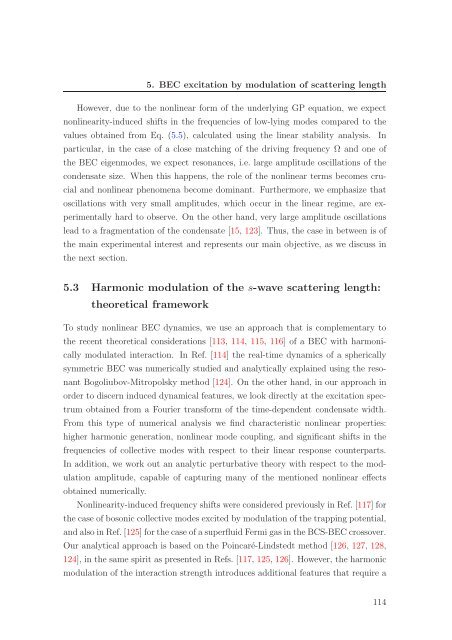PhD thesis in English
PhD thesis in English
PhD thesis in English
You also want an ePaper? Increase the reach of your titles
YUMPU automatically turns print PDFs into web optimized ePapers that Google loves.
5. BEC excitation by modulation of scatter<strong>in</strong>g lengthHowever, due to the nonl<strong>in</strong>ear form of the underly<strong>in</strong>g GP equation, we expectnonl<strong>in</strong>earity-<strong>in</strong>duced shifts <strong>in</strong> the frequencies of low-ly<strong>in</strong>g modes compared to thevalues obta<strong>in</strong>ed from Eq. (5.5), calculated us<strong>in</strong>g the l<strong>in</strong>ear stability analysis. Inparticular, <strong>in</strong> the case of a close match<strong>in</strong>g of the driv<strong>in</strong>g frequency Ω and one ofthe BEC eigenmodes, we expect resonances, i.e. large amplitude oscillations of thecondensate size. When this happens, the role of the nonl<strong>in</strong>ear terms becomes crucialand nonl<strong>in</strong>ear phenomena become dom<strong>in</strong>ant. Furthermore, we emphasize thatoscillations with very small amplitudes, which occur <strong>in</strong> the l<strong>in</strong>ear regime, are experimentallyhard to observe. On the other hand, very large amplitude oscillationslead to a fragmentation of the condensate [15, 123]. Thus, the case <strong>in</strong> between is ofthe ma<strong>in</strong> experimental <strong>in</strong>terest and represents our ma<strong>in</strong> objective, as we discuss <strong>in</strong>the next section.5.3 Harmonic modulation of the s-wave scatter<strong>in</strong>g length:theoretical frameworkTo study nonl<strong>in</strong>ear BEC dynamics, we use an approach that is complementary tothe recent theoretical considerations [113, 114, 115, 116] of a BEC with harmonicallymodulated <strong>in</strong>teraction. In Ref. [114] the real-time dynamics of a sphericallysymmetric BEC was numerically studied and analytically expla<strong>in</strong>ed us<strong>in</strong>g the resonantBogoliubov-Mitropolsky method [124]. On the other hand, <strong>in</strong> our approach <strong>in</strong>order to discern <strong>in</strong>duced dynamical features, we look directly at the excitation spectrumobta<strong>in</strong>ed from a Fourier transform of the time-dependent condensate width.From this type of numerical analysis we f<strong>in</strong>d characteristic nonl<strong>in</strong>ear properties:higher harmonic generation, nonl<strong>in</strong>ear mode coupl<strong>in</strong>g, and significant shifts <strong>in</strong> thefrequencies of collective modes with respect to their l<strong>in</strong>ear response counterparts.In addition, we work out an analytic perturbative theory with respect to the modulationamplitude, capable of captur<strong>in</strong>g many of the mentioned nonl<strong>in</strong>ear effectsobta<strong>in</strong>ed numerically.Nonl<strong>in</strong>earity-<strong>in</strong>duced frequency shifts were considered previously <strong>in</strong> Ref. [117] forthe case of bosonic collective modes excited by modulation of the trapp<strong>in</strong>g potential,and also <strong>in</strong> Ref. [125] for the case of a superfluid Fermi gas <strong>in</strong> the BCS-BEC crossover.Our analytical approach is based on the Po<strong>in</strong>caré-L<strong>in</strong>dstedt method [126, 127, 128,124], <strong>in</strong> the same spirit as presented <strong>in</strong> Refs. [117, 125, 126]. However, the harmonicmodulation of the <strong>in</strong>teraction strength <strong>in</strong>troduces additional features that require a114
















